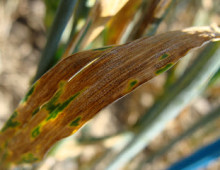Director Rubin on corngrass1 for biofuel
Up to now, the fast-growing switchgrass, because of its tough lignin, an organic polymer, has required heavy chemical treatment before it can be turned to ethanol as biofuel. Chuck’s gene transfer experiments have shown that because the improved switchgrass keeps the plants young, the lignin content of their cells is minimal and would need no… [Read More]
